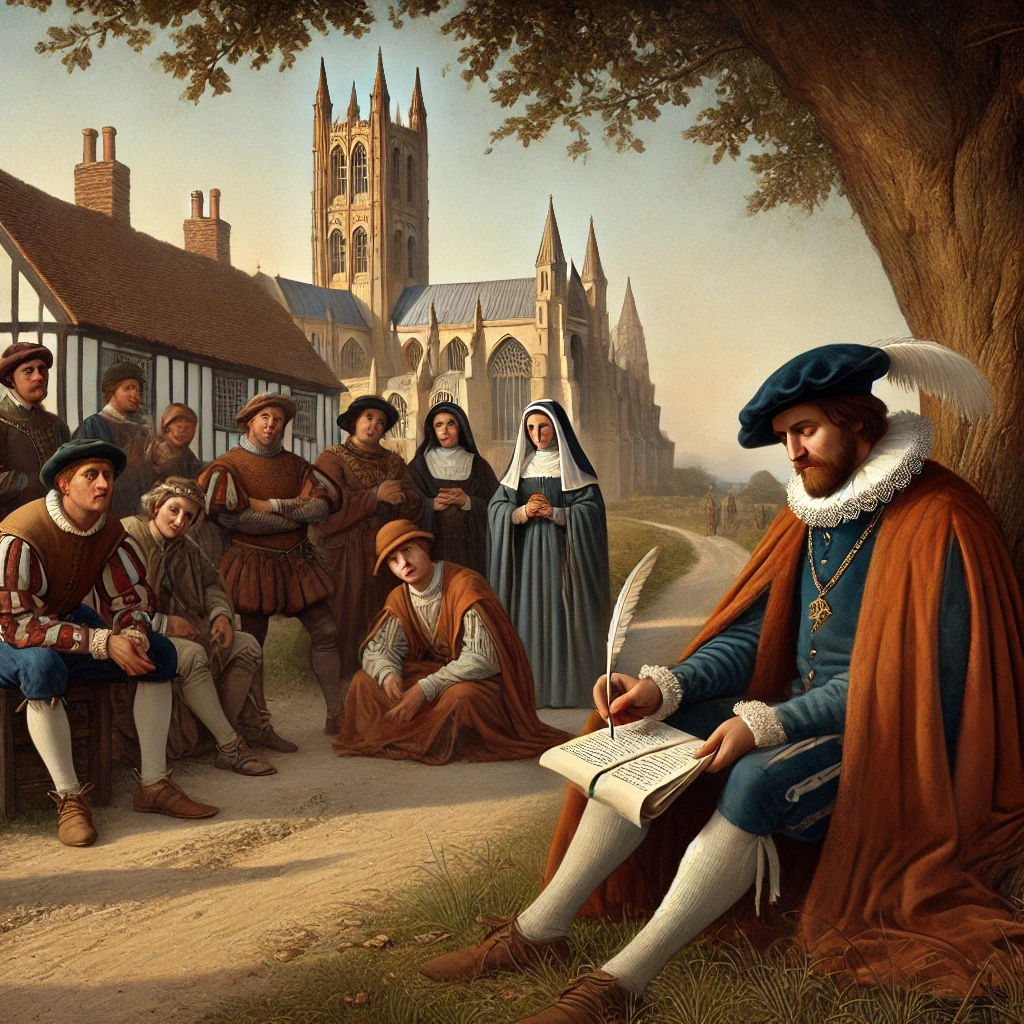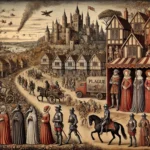By ABS, The Literary Scholar
(Who firmly believes the Wife of Bath invented the “tell-all” format before TV caught up)
Welcome to “The Canterbury Tales”: Medieval England’s Original Road Trip Series
Before Bigg Boss, before Keeping Up with the Kardashians, before Netflix had time to buffer, there was a bunch of medieval pilgrims on their way to a shrine—deciding to entertain themselves with a storytelling contest.
The result?
Geoffrey Chaucer’s The Canterbury Tales—the literary equivalent of a tour bus filled with 30 strangers, all gossiping, flirting, and passive-aggressively insulting each other through metaphors.
“And gladly wolde he lerne, and gladly teche.” — Chaucer
(Translation: Nerd alert.)
The Setting: A Pub, A Shrine, and A Wild Plot Device
So here’s the premise, because yes—The Canterbury Tales has one, and it’s surprisingly binge-worthy.
A bunch of people meet at the Tabard Inn in Southwark, London, and agree to travel together to Canterbury Cathedral to visit the shrine of Saint Thomas Becket. But instead of playing cards or silently judging each other’s luggage, they agree to a storytelling contest.
The prize? A free dinner.
The judge? Harry Bailly, the innkeeper and part-time drama instigator.
The vibes? Unfiltered.
The Pilgrims: Archetypes, Drama, and Allegedly Holy Intentions
Let’s be honest: Chaucer didn’t just give us pilgrims—he gave us characters. Big personalities. Secret backstories. Enough sass to fuel a Netflix medieval reboot.
Here are a few fan-favorites:
1. The Knight – The OG soft-spoken hero
He’s noble, modest, and has been on so many crusades he probably has Air Miles. Chaucer praises him with all the grace of a man who clearly has a crush on chivalry.
“A verray, parfit gentil knyght.”
But let’s be honest, this guy’s more “LinkedIn warrior” than action star at this point. His tale is about honor, romance, and fate—a classic gentleman move.
2. The Squire – The Knight’s influencer son
Young, curly-haired, and probably writing love ballads in his notes app. He fights in wars, yes, but also sings, dances, draws, and wears embroidered outfits. He’s giving major “I’m just here to vibe” energy.
3. The Wife of Bath – The Real Housewife of 14th Century England
Five husbands in, unapologetically sensual, and deeply wise in the ways of the world (and men). She’s a feminist before feminism had a name—and a master of poetic shade.
“Experience, though noon auctoritee, / Were in this world, is right ynogh for me.”
Translation: I don’t need dead men in books to tell me what I already know.
Her tale? It’s got magic, marriage, and a reformed knight who learns to respect women. Girl boss energy, medieval edition.
4. The Pardoner – The walking, talking warning label
A hypocrite wrapped in silk and relics. He preaches against greed while selling fake holy artifacts like bone fragments and pillowcase “veils” of the Virgin Mary.
“Radix malorum est cupiditas.” — The root of all evil is greed.
Also him: “Please give generously to my greed.”
Honestly, he’d have an Instagram bio that says: “Repent now, but tip via Venmo.”
5. The Miller – Loud, bawdy, probably banned from quiet zones
He’s drunk before they even leave the inn, interrupts everyone, and tells a tale full of toilet humor, adultery, and butt jokes. Imagine if Chaucer had access to modern meme culture—this guy would’ve been a content creator.
6. The Prioress – Aesthetic Nun, loves dogs and table manners
She speaks French (poorly), cries over dead mice, and wears jewelry that says “Love conquers all.” Deep down, you know she’s cosplaying as holiness.
The Vibe: Satire Disguised as Piety
Chaucer’s genius lies in how he pretends to just “record” the pilgrims’ tales—but is actually roasting everyone along the way. He satirizes clergy, nobility, merchants, and even poets (including himself).
He gives us:
Religious figures who are corrupt
Nobles who are fragile
Peasants who are shrewd
Women who speak their minds (gasp!)
It’s like he peeked behind the curtain of society and whispered, “Let me tell you who these people really are.”
The Language: Middle English, But Make It Musical
Reading Chaucer in Middle English sounds like casting a spell, but when read aloud, it sings.
“Whan that Aprill with his shoures soote…”
Even if you don’t know what it means, it sounds like the weather’s about to get poetic.
His rhyming couplets are sharp, rhythmic, and filled with irony. And unlike some other “literary greats,” Chaucer wasn’t afraid of dirty jokes, bodily functions, or social rebellion.
Why The Canterbury Tales Still Slaps in 2025
It’s Reality TV before Reality TV existed
Everyone’s got a story, an ego, and something to prove.
The Wife of Bath is still more honest than half of modern influencers.
It breaks the fourth wall with flair
Chaucer inserts himself as “the narrator” and then has everyone insult his tale.
Meta before meta was a thing.
It exposes human nature in full color
Hypocrisy, lust, pride, greed, kindness, foolishness—all rolled into rhyming couplets.
It’s humanity laid bare… just with a horse and a rosary.
ABS Recommends: How to Read Chaucer Without Losing Your Sanity
Read it aloud—Middle English sounds better than it looks.
Start with the Wife of Bath’s Prologue and Tale—pure fire.
Use a parallel text version—unless you enjoy suffering.
Imagine each character as someone you know on Instagram. It helps.
Final Thoughts: Chaucer Was the Moment
Geoffrey Chaucer gave us:
A literary masterpiece
A time capsule of 14th-century life
A character-driven spectacle full of drama, depth, and delightful disobedience
“And of his craft he was a carpenter…” — The Miller’s Tale
Just a reminder: that tale ends with someone getting a red-hot poker up the you-know-what.
Chaucer didn’t just write tales—he dropped scandalous mic moments in poetic form.
So next time you hear someone say “medieval literature is boring,” offer to read them The Miller’s Tale… over wine.
They’ll never think of bathtubs, astrology, or kisses the same way again.
Scroll closed. Characters forever alive in rhyme.
ABS bows, exits with a medieval wink.
When pilgrims spoke, society confessed—verse by verse.
Signed,
ABS, The Literary Scholar
By ABS, The Literary Scholar
(Because poetry isn’t the only thing that wore a black cloak in the 1300s)
Share this post / Spread the witty word / Let the echo wander / Bookmark the brilliance


